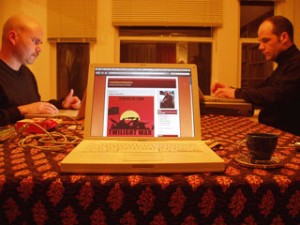Personal Best: The Decade in Music
It wasn’t that long ago that the prospect of compiling a list of the year’s best albums delighted me. But now such a task feels more like a burden. I’m older, for one thing. I fear I’ve commenced the same ripening I once derided in my elders, in which events start to run together like the bottom rows of letters on the optometrist’s chart. That said, the difficulty I’ve had mentally dating records isn’t merely a function of my age. Critics and fans alike have repeatedly remarked that it seems harder to separate the products of one year from its predecessor. Between reissue culture, which gives us the opportunity to purchase what we already own in a new and improved form, and the complications that downloading introduces into the consumer experience, making songs available online before they are packaged in a physical album, the potential for chronological confusion is greater than ever. As I sat down to make notes for my end-of-year list, I discovered that some of the music I listened to most this year had either been released prior to 2009 or was scheduled to be released in 2010.
That’s why I felt an enormous sense of relief when I noticed that many publications were emphasizing the past decade rather than the past year. Covering ten years instead of one may seem much harder, but there’s comfort in knowing that the main difficulty is excess rather than lack. I found solace in the realization that whatever list of the decade’s best music I came up with was likely to seem idiosyncratic and arbitrary. Indeed, I couldn’t imagine producing an end-of-decade list that wasn’t autobiographical. Rather than sorting through vast quantities of music in search of what was objectively superior, I would be able to concentrate on the albums that had the largest impact on me. In some cases these would simply be my favorite records. But in others, presence on the list would register impact.
Although other publications may have presented their end-of-decade Top Tens in the best-of format, it was clear from the way most were written than their contributors were using the same mode of selection that I had chosen. This reinforced my impression that the past ten years have witnessed a remarkable transformation in the function of criticism. The development of the internet has made the distinction between insider and outsider, professional and amateur harder and harder to maintain.
The expertise of music critics was once regarded as the direct result of their access to a range of content that ordinary consumers simply couldn’t afford. But as the file-sharing made possible by Napster and its less storied successors gave even impecunious fans the opportunity to flesh out their music collections without having to pay for the privilege, critics could no longer fall back on the claim that they were better informed about music than everybody else. Indeed, nowadays critics often find themselves at a disadvantage. Professional concerns, not to mention personal fears, make it difficult for them to obtain music outside of official channels. Whereas the illegal downloader down the street can augment her or his collection with vast quantities of “free” material every week, critics have to rely on publicists and legal sites like MySpace and iTunes to do their research.
The outcome of this reversal is that critics now have to legitimate their presumed expertise, not on the quantity of content they have sorted through, but the quality of the judgments they make about the material they do encounter. This is why critics are increasingly likely to reference academic training in their reviews and features. While they might not have privileged access to content anymore, the tools with which they make sense of it set them apart from the bulk of music fans. It’s no accident that the precipitous decline of traditional journalism, inextricably bound up with the proliferation of user-generated content, has produced a concomitant rise in the number of critics who work in academia. Just as it was long the case that the vast majority of poets had to teach in order to support themselves, most critics find themselves forced to supplement their music writing with a day job or two.
This trend has effectively turned many of our most seasoned critics into de facto amateurs, people who pass judgment on music because it’s their passion rather than their profession. In a sense, the autobiographical trend in music criticism, reflected in end-of-decade and even end-of-year lists, is the outcome of this unsettling metamorphosis. When you’re writing for love rather than money, it no longer makes sense to restrain the confessional element in your lists. Given the fact that the music industry is in nearly as bad shape as journalism, the only sensible course of action may be to make a case for what matters personally. Certainly, the only reason that artists and critics alike can hope to sustain themselves in the future is by providing music lovers a service so valuable that paying for it feels like a personal obligation rather than a legal requirement.
Yet despite the appeal and, indeed, necessity of making my end-of-decade list a reflection of my own tastes and experiences, I was unable to ignore other concerns. My years of preparing course syllabi, in which I’d learned to balance personal preference with acknowledgment that not everyone shares my taste, led me to the conclusion that my list would have to make nods to generic diversity. Just as a course in which every book was a close approximation of Thomas Pynchon’s The Crying of Lot 49 would not be very helpful to students in need of literary breadth, an end-of-decade list populated by the bands most influenced by Pavement would take self-indulgence too far. Rather than simply list what I listened to most or liked best, then, I came up with a list that reflects the records in different genres that made the biggest impression on me. Here goes:
• Broken Social Scene - Broken Social Scene: Yes, the title of one song name-checks Pavement. But what I’ve come to appreciate about this album, in years of running and bicycling to its contents, is the way that it functions like a palimpsest for alternative music more generally. Its beauties may be submerged in noise or deferred by fragmentary introductions and rambling codas, but that makes them even more poignant.
• DJ Danger Mouse - The Gray Album: The best album you will never be able to buy. The decision to fuse Jay-Z’s acappella version of The Black Album with The Beatles’ White Album was ingenious by itself. But the execution made it the most compelling hip-hop record of the decade.
• Neko Case - Furnace Room Lullaby: Everything this alternative country chanteuse touches turns to heartbreakingly wonderful filigree, but this album wins out for me because it introduced my family to her charms. My daughter could recognize Case’s voice in seconds thanks to the number of times she listened to tracks like “Porchlight” and “Twist the Knife”.
• Modest Mouse - Good News For People Who Love Bad News: I have a knack for falling love with the same records by artists that make longtime devotees of their music fall out of love. I still can’t see how anyone who was ever seduced by Issac Brock’s ramshackle melancholy could reject this album, even if it did elevate the band to the top of the rock-and-roll charts. Commercial success isn’t always an index of aesthetic failure.
• The Notwist - Neon Golden: Many artists have tried to fuse rock, electronica and hip-hop over the years. But such alchemy results in lead more often than precious metals. The Notwist is the exception. Referencing everything from Love to Kraftwerk to Tricky, this band still manages to produce records with their own unique molecular structure. This album evokes the bittersweet with extraordinary subtlety.
• Amy Winehouse - Back To Black: Now that she has become tabloid fodder of the worst sort, it can be hard to remember just how tremendous her music is. This was the best soul album of the decade, even though she is neither black nor American. Sometimes authenticity is beside the point. It’s not just her voice, either, which continues to amaze. The beats are the equal of any.
• Burial - Untrue: There are other dub-influenced records that do a better job of recasting the reggae tradition. And others that work better in the club. But none of them have had the impact or staying power of Burial’s haunting masterpiece. It’s the perfect soundtrack for life during perpetual wartime.
• Fleet Foxes - Fleet Foxes: The first time I heard this album I felt like I’d known it for decades. I can’t think of a better testament to this band’s brilliance. They’re even better live than on record, which is a scary thought considering how superb this full-length debut is. If you have hankerings for the heyday of classic rock at its folkiest, but don’t want to spend all your time in the thrall of nostalgia, Fleet Foxes are your salvation.
• Exploding Hearts - Guitar Romantic: You might seek this record out for the tragic tale of the band, its promising career cut short by a terrible automobile accident that killed three of its members. You will stay, though, for the best pop punk this side of The Buzzcocks. The songwriting is as insouciant as the no-fi production.
• Bloc Party - Silent Alarm: A perfect synthesis of propulsion and restraint, rage and introspection, this album reimagined the hybridization of ska and punk with remarkable vigor and care. If you want a record to speed up your heart rate without slowing down your mind, this is the one to choose. I still need my fixes of New Order and The Cure, but of all recent music Bloc Party comes the closest warding off withdrawal symptoms.
• Califone - Roots and Crowns: I labored to love this record over a period of months, alternately absorbed by its auratic timbres and repelled by the absence of full-fledged melodies. I realize now, though, that the album’s “negative space” quality, the way it seems like the background for a foreground under erasure, perfectly encapsulates the approach of post-rock songsmiths less concerned with product than process.
• Evan Dando - Live at the Brattle Theater: The latter portion of the 2000s saw the return of many alternative artists from the Lollapalooza era, including The Lemonheads. But this album, released at the beginning of the decade when Dando was still in the wilderness of post-addiction and post-rock, remains my favorite “comeback.” The purity and strength of songs like “Down About It” and “My Drug Buddy” shimmers through the diaphanous solo performance.
![[the current issue of ZEEK]](../../image/2/100/0/5/uploads/leftistethicistgraphic-52842c6a.png)
- 5000 Pages of Zeek
- Founded in 2001, Zeek was the first Jewish online magazine, and we have over 5000 pages online to prove it, all available free of charge. Read more in the Archive.
More articles by
Charlie Bertsch
More articles in
Arts and Culture
- Euphoria, Curiosity, Exile & the Ongoing Journey of a Hasidic Rebel: A Q & A with Shulem Deen
- Poet Q, Poet A: Jews Are Funny! Six Poets on Jewish Humor, Poetry & Activism and Survival
- Tackling Hate Speech With Textiles: Robin Atlas in New York for Tu B’Shvat
- Fiction: Angels Out of America
- When Is an Acceptance Speech Really a Speech About Acceptance?



